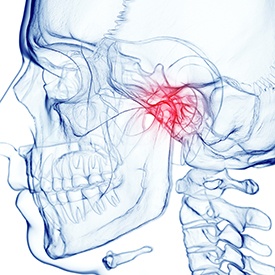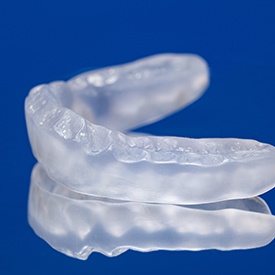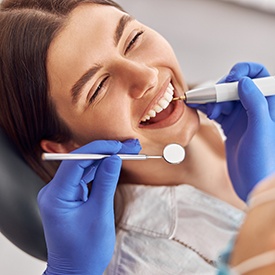TMJ Treatment – Mesquite
Addressing Frequent Jaw Pain
 Have you noticed that your jaw pops, clicks, or hurts when you chew your food? Do you experience frequent headaches or earaches? You may have temporomandibular disorder (TMD). This is when the jaw joints aren’t functioning properly, leaving you with numerous uncomfortable symptoms. At OS Dental, we offer multiple TMJ treatment options to give you some relief. Read on to learn more about TMD and how we can help.
Have you noticed that your jaw pops, clicks, or hurts when you chew your food? Do you experience frequent headaches or earaches? You may have temporomandibular disorder (TMD). This is when the jaw joints aren’t functioning properly, leaving you with numerous uncomfortable symptoms. At OS Dental, we offer multiple TMJ treatment options to give you some relief. Read on to learn more about TMD and how we can help.
What Is TMJ Disorder?

Your TMJ, also called your temporomandibular joint, is a set of smile hinges located in front of your ears. This joint allows your lower jaw to move up and down when you speak, laugh, and talk. The TMJ is one of the most complex joints in the body, so it can be disturbed by a misaligned bite, teeth grinding, and other factors. When it happens, you have TMJ disorder, or TMD.
Symptoms of TMJ Disorder

There are numerous symptoms of TMD. Here are some of the most prominent ones that are experienced:
- Headaches: One of the most underdiagnosed causes of frequent headaches is TMD. The jaw muscles become tense, strained, and overworked, so it is easy for this to affect the nearby muscles in the head.
- Ear Pain: Since the TMJ is located next to the ears, having a dysfunctional joint can easily result in ear pain. It can also cause ringing in the ears, known as tinnitus.
- Face/Jaw Pain: Jaw stiffness and pain are the most common symptoms of TMD. It can be difficult to chew comfortably, and lockjaw is common.
- Bruxism: Teeth clenching and grinding can be caused by daily stress, a misaligned bite, and TMD. It usually happens during sleep and can overwork the jaw muscles, leading to additional pain.
Types of TMJ Treatment
Depending on the severity and cause of your TMD, there are several treatment options available. Here are the options that we offer.
Occlusal Splint

An occlusal splint is a customized orthotic device that can be worn to reduce the prevalence of TMD symptoms. Each device is customized for the patient and needs to be worn during sleep. It works by shifting the jaw into the ideal position to relieve your joints of additional strain and stress. It can also reduce the harmful effects of teeth grinding and clenching.
Equilibration/Occlusal Adjustment

If the cause of your TMD pain is bite misalignment or an improperly placed restoration, we might suggest occlusal adjustments. During this time, we will strategically and gently reshape your teeth so that they come together in a more functional manner that doesn’t cause your joints to be strained. To pinpoint the area of your bite that may be under additional pressure, we will take a pressure of your teeth and gently buff them down for lasting relief.
Vivera Retainers

Another treatment option that we often recommend is Vivera retainers. This type of retainer is often given to patients after they complete Invisalign treatment. What many people don’t know is that these retainers can also relieve pressure of the jaw, reducing pain. This is because it causes your muscles to relax while you sleep, taking away the tension on your TMJ.
NTI Appliance

NTI is a shorted abbreviation for Nociceptive Trigeminal Inhibition Tension Suppression System (NTI-TSS). This appliance is a small acrylic occlusal splint that is customized to fit over two upper or four lower anterior teeth. It is worn during sleep. Many patients find this appliance to be more comfortable than standard occlusal splints.
TMJ Treatment FAQs
Is TMJ Treatment Safe?
TMJ treatment is a typically safe solution so long as it’s provided by a qualified professional. In many cases, some dentists can offer non-invasive methods such as occlusal adjustments, which even the National Institutes of Health recommends as a reliable and safe option for managing TMJ disorders. Our Mesquite team will also walk you through your treatment plan and discuss any concerns you might have before starting, that way you can be as comfortable as possible.
How Long Does TMJ Treatment Take?
The length of your TMJ treatment will be different from other patients based on both the specific method used and the severity of your situation. With occlusal adjustments, you can usually expect a relatively swift process, and you should notice the difference once your bite has been corrected. The timeline, however, will depend on the necessary changes that we’ll need to make. For some people, more lasting relief can be accomplished after several weeks or months of treatment. During your consultation, our team can provide you with a more accurate estimation based on your specific needs.
Can TMJ Be Cured Permanently?
It isn’t always the case that temporomandibular joint disorder (TMD) can be completely cured, but you’ll still want to try managing it as effectively as possible. There are some solutions, like certain home remedies, that can provide fast but temporary alleviation. For more long-term results, you’ll want to speak with a professional about options like occlusal adjustments, which help relieve the jaw muscles and minimize teeth grinding, allowing you longer-lasting relief of TMJ symptoms. You might even consider combining short-term and long-term methods for the best outcomes, that way you can find a strategy that fits your lifestyle while making your jaw more comfortable in the long run.
Does Occlusal Adjustment for TMJ Hurt?
Undergoing an occlusal adjustment for TMJ disorder is typically not a painful process. For your treatment, our team will first carefully file a small amount of your teeth or dental restoration(s) to ensure your bite is balanced while also relieving any stress on your jaw. We’ll use a small dental drill to perform this, but we’ll also provide you with a local anesthetic to ensure that you’re completely pain-free during the process. Afterward, you may experience mild soreness, but this should be short-lived and go away after a few days. Remember that our team will want you to feel comfortable throughout your procedure, and we’ll do everything we can to make sure your treatment goes smoothly.